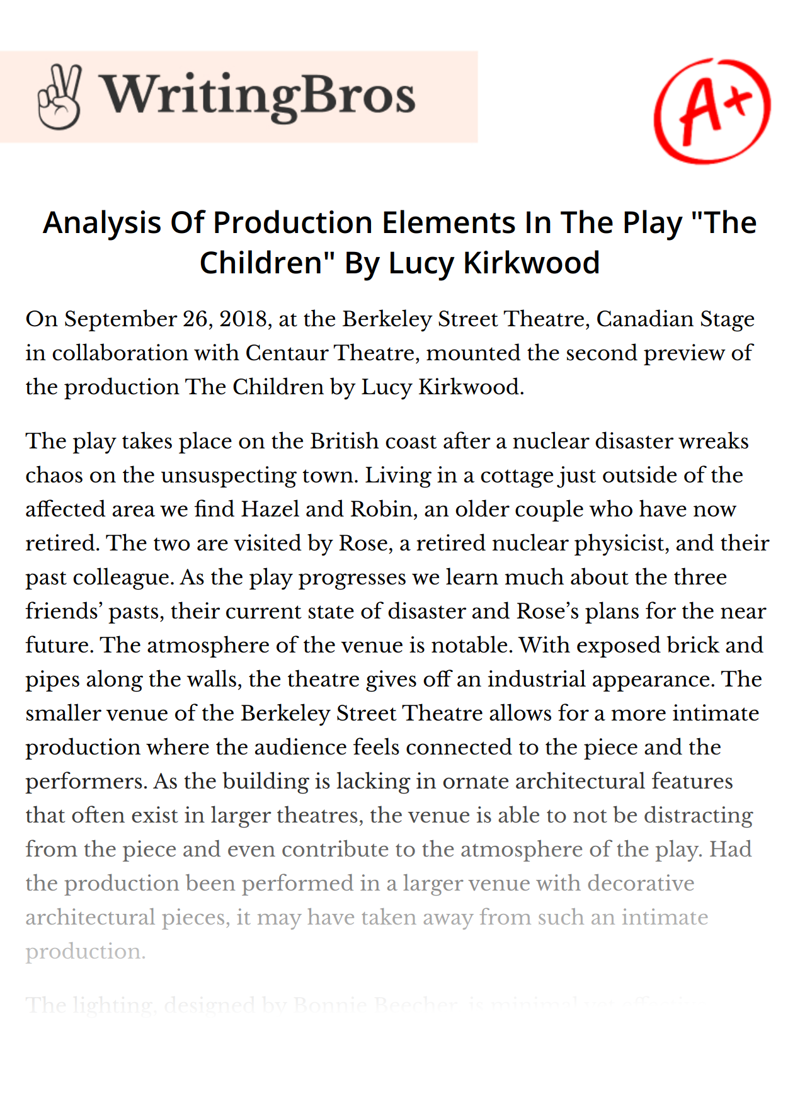Analysis Of Production Elements In The Play "The Children" By Lucy Kirkwood

On September 26, 2018, at the Berkeley Street Theatre, Canadian Stage in collaboration with Centaur Theatre, mounted the second preview of the production The Children by Lucy Kirkwood.
The play takes place on the British coast after a nuclear disaster wreaks chaos on the unsuspecting town. Living in a cottage just outside of the affected area we find Hazel and Robin, an older couple who have now retired. The two are visited by Rose, a retired nuclear physicist, and their past colleague. As the play progresses we learn much about the three friends’ pasts, their current state of disaster and Rose’s plans for the near future. The atmosphere of the venue is notable. With exposed brick and pipes along the walls, the theatre gives off an industrial appearance. The smaller venue of the Berkeley Street Theatre allows for a more intimate production where the audience feels connected to the piece and the performers. As the building is lacking in ornate architectural features that often exist in larger theatres, the venue is able to not be distracting from the piece and even contribute to the atmosphere of the play. Had the production been performed in a larger venue with decorative architectural pieces, it may have taken away from such an intimate production.
The lighting, designed by Bonnie Beecher, is minimal yet effective. Upon entering the theatre, the house lights are dim, with blue and green lights casting a cool wash across the stage. This combined with small amounts of haze above the stage contribute to an eerie tone, lending to the concept of a recent nuclear disaster. Along the stage floor on stage left, 6 small lit squares appear, giving the illusion of sunlight coming through a set of windows that exist on the side of the room. This lends greatly to the realism of the play and the believability of the set as an actual cottage. Once the play begins the lighting effects are minimal, dealing in majority only with changes in intensity. Within the play, there is a shortage of electricity, caused by the nuclear explosion this leads the characters to rely on natural sunlight as their only lighting for the majority of the play. The effect is achieved through the gradual dimming of the stage lights giving the sense of the setting sun incredibly well. When electricity is once again available to the characters, the lighting flickers on to a stark, bright light showing the artificial lighting that has been lacking throughout previous scenes of the production. During the final scene of the play, the door to the outside is opened and the lights shift from white to blue. The blue lights give the feeling of being by the ocean without as much eerie sensation as had been seen at the top of the play with the green lighting. This gives the audience a sense of calm and acceptance that the production seems to be trying to achieve.
Sound, designed by John Gzowski, is the least extensive element in the show. This said it still plays a large role in maintaining the mood of the play. For instance, playing the song “Get Up Offa That Thing” by James Brown allows for a very comedic moment where all of the characters get up and dance around the stage. Another important moment for sound comes at the end of the play when the door to outside opens and the stage is basked in blue light. As this happens the sound of the ocean can be heard, similar to the blue light this leads to the feeling of calm and acceptance, a final moment to punctuate the play. Though costuming, designed by Eo Sharp, is limited in this production, it still plays a large role in the believability and realism of the play, as does hair and makeup. As Rose, a friend of Hazel and Robin, enters the scene she wears black dress pants and a blouse, a typical outfit of a woman somewhere between her sixties and seventies. She has red under her nose that has dripped onto her shirt from the nosebleed that Hazel has given her. Rose also wears a short blonde wig, used to cover up the fact that she has been undergoing cancer treatment. When Hazel snatches the wig off of roses head we see that she has lost all of her hair. The effect of having a bald head was well executed and contributed greatly to the moment of realization that Hazel has in seeing Rose’s sickness. Hazel wears black leggings and a button up, indicative of someone who is attempting to hold onto their youth. Once Robin enters we notice he is dressed in a flannel and jeans, again a typical outfit of someone in their sixties who enjoys farming. The muted colors of all three costumes blend well into the muted set making no one character appear more important than another.
Though many production elements appeared minimal, there is quite obviously a great deal of work that was put into this play. The immense effort led to a production that was realistic and believable. Every production element helped to create a piece that was cohesive and told the story well.
Cite this Essay
To export a reference to this article please select a referencing style below

